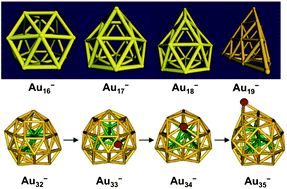Probing the electronic properties and structural evolution of anionic gold clusters in the gas phase
Abstract

- This article is part of the themed collection: Metallic clusters
* Corresponding authors
a Department of Physics and Astronomy, University of Pittsburgh, Pittsburgh, Pennsylvania 15260, USA
b
Department of Chemistry, Brown University, Providence, Rhode Island 02912, USA
E-mail:
lai-sheng_wang@brown.edu

 Please wait while we load your content...
Something went wrong. Try again?
Please wait while we load your content...
Something went wrong. Try again?
L. Wang and L. Wang, Nanoscale, 2012, 4, 4038 DOI: 10.1039/C2NR30186E
To request permission to reproduce material from this article, please go to the Copyright Clearance Center request page.
If you are an author contributing to an RSC publication, you do not need to request permission provided correct acknowledgement is given.
If you are the author of this article, you do not need to request permission to reproduce figures and diagrams provided correct acknowledgement is given. If you want to reproduce the whole article in a third-party publication (excluding your thesis/dissertation for which permission is not required) please go to the Copyright Clearance Center request page.
Read more about how to correctly acknowledge RSC content.
 Fetching data from CrossRef.
Fetching data from CrossRef.
This may take some time to load.
Loading related content
